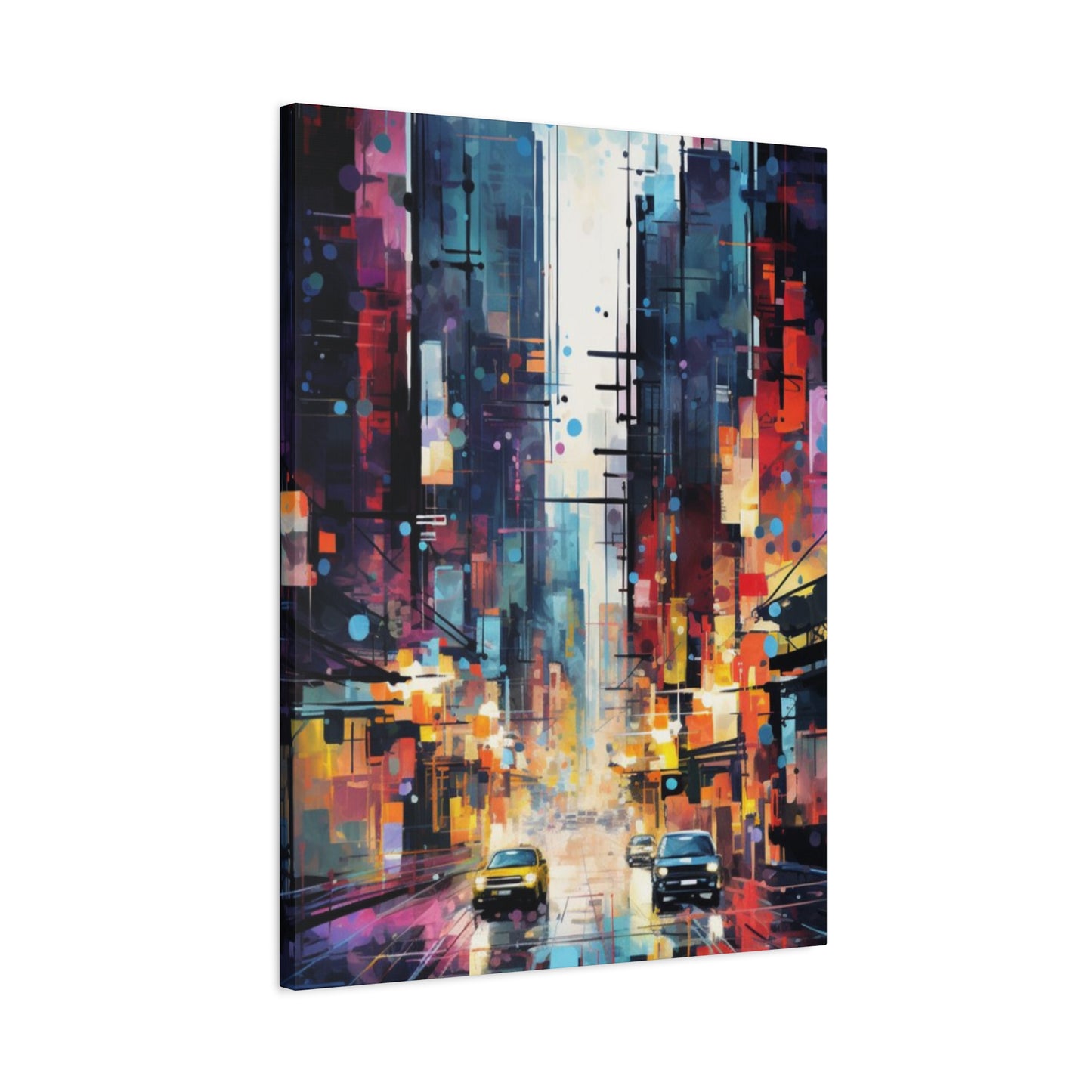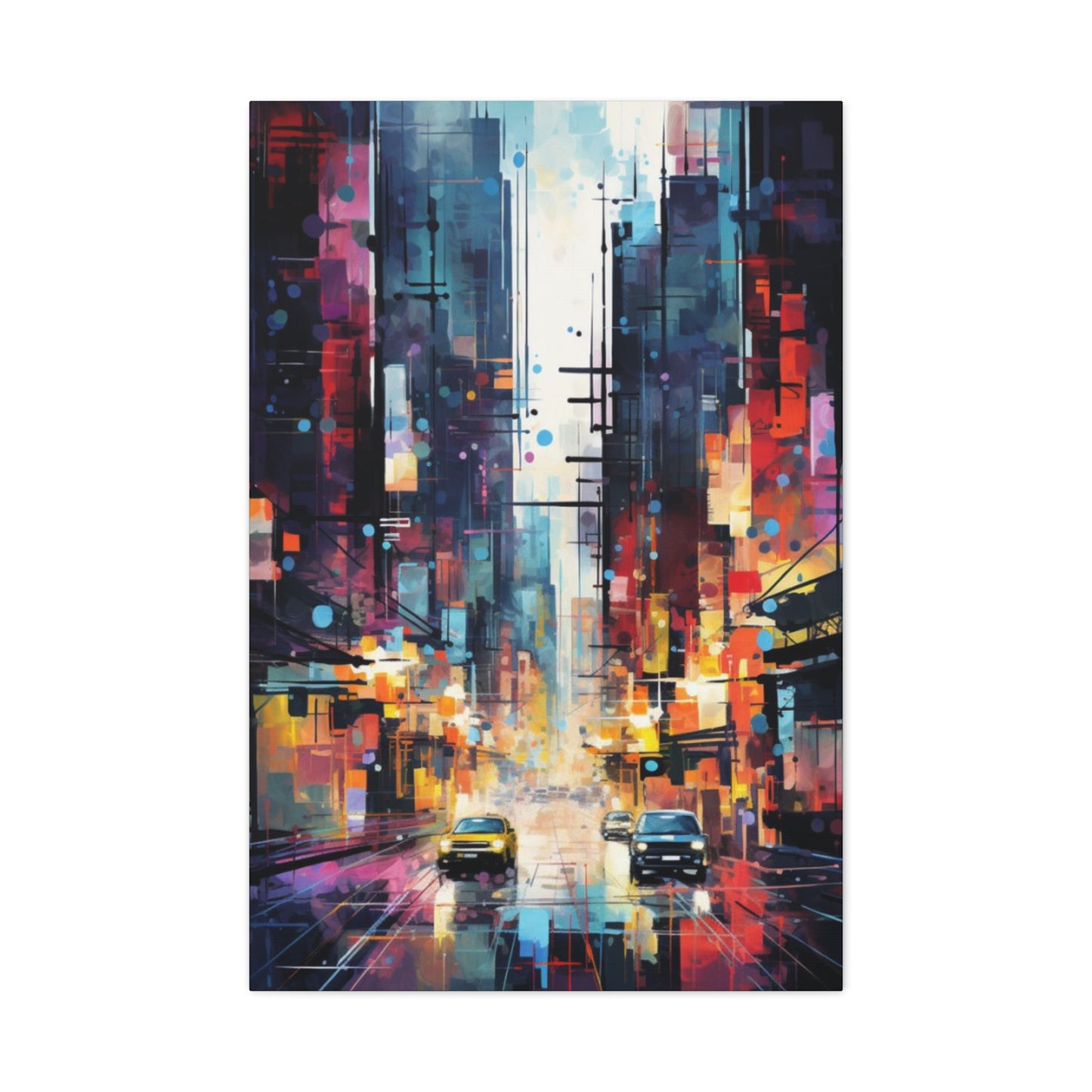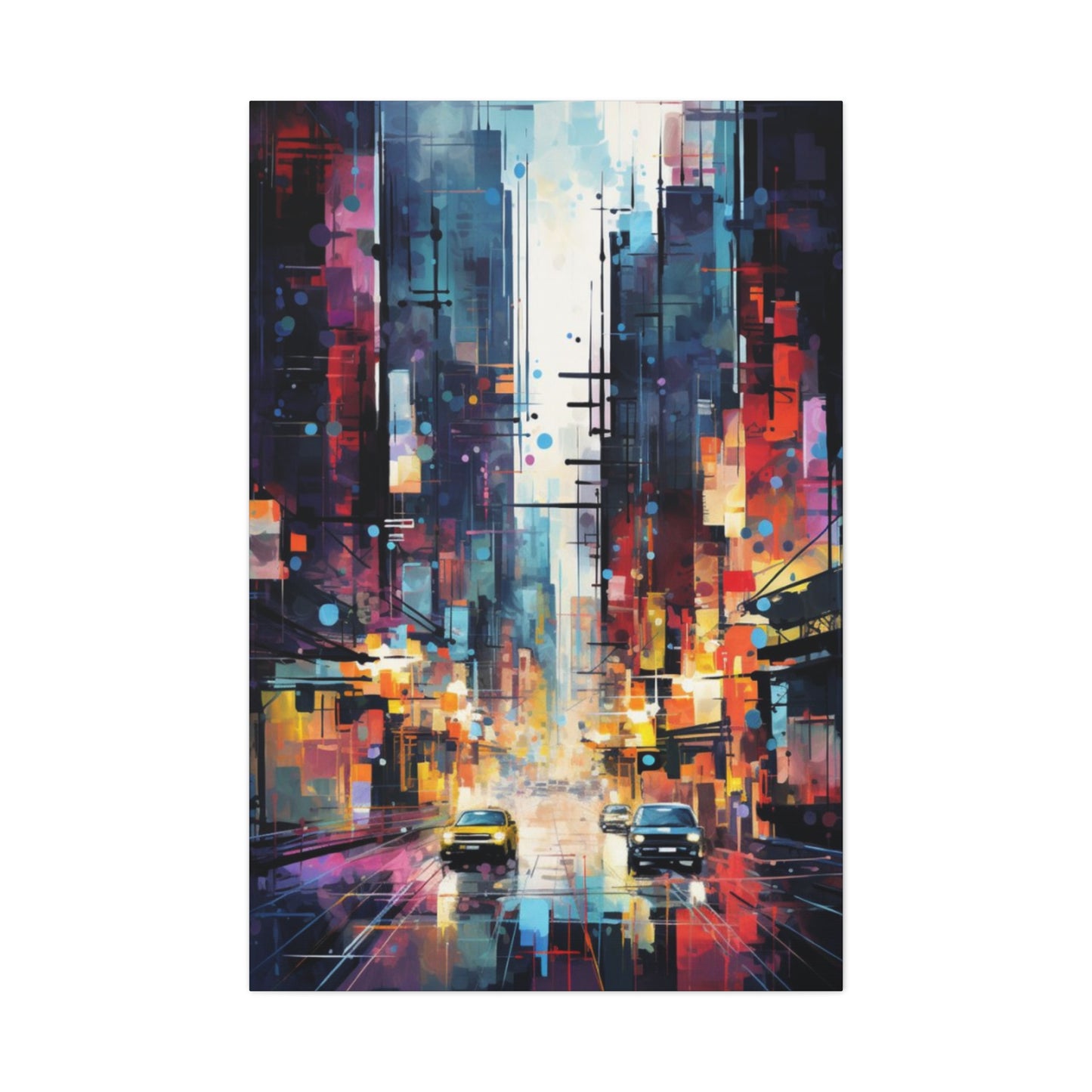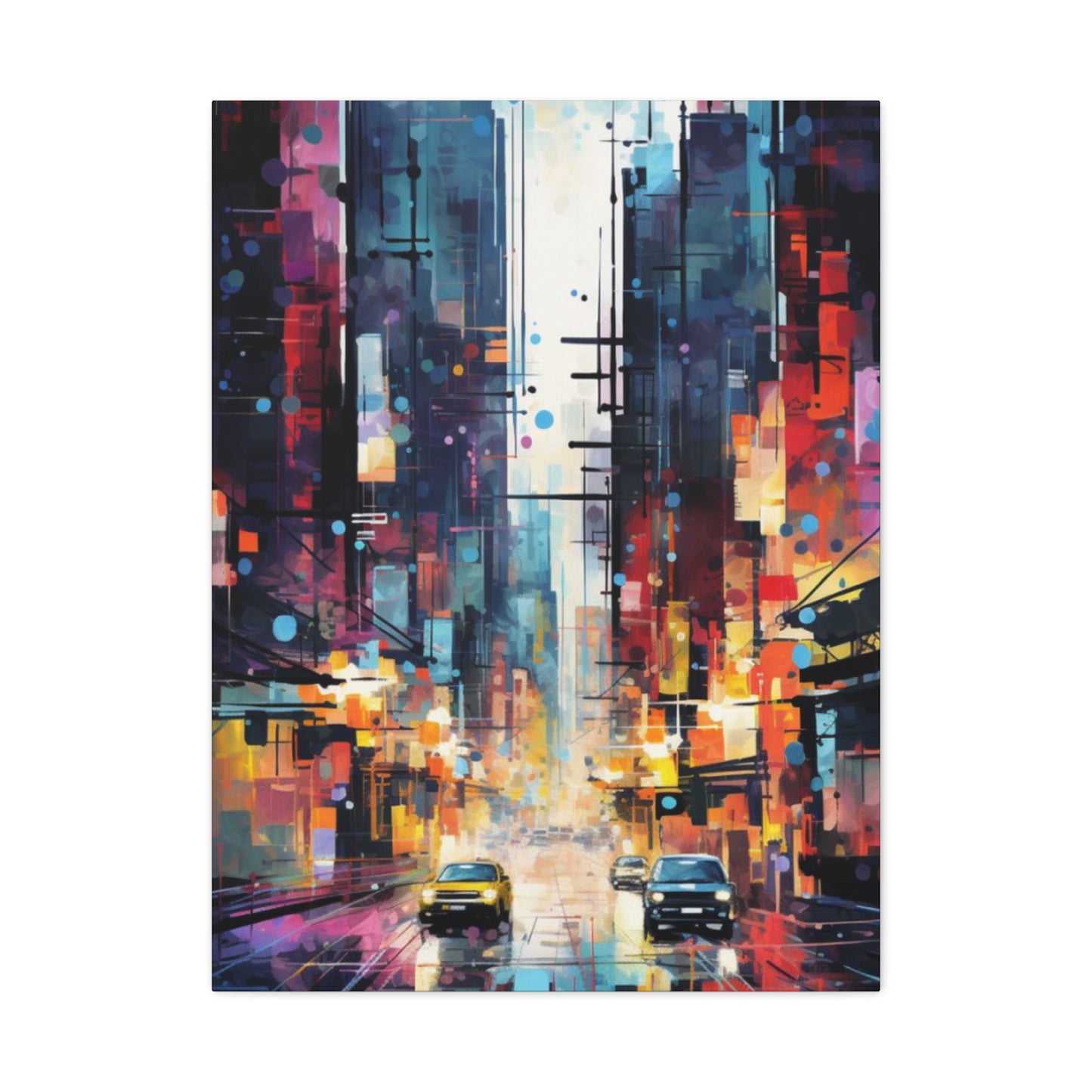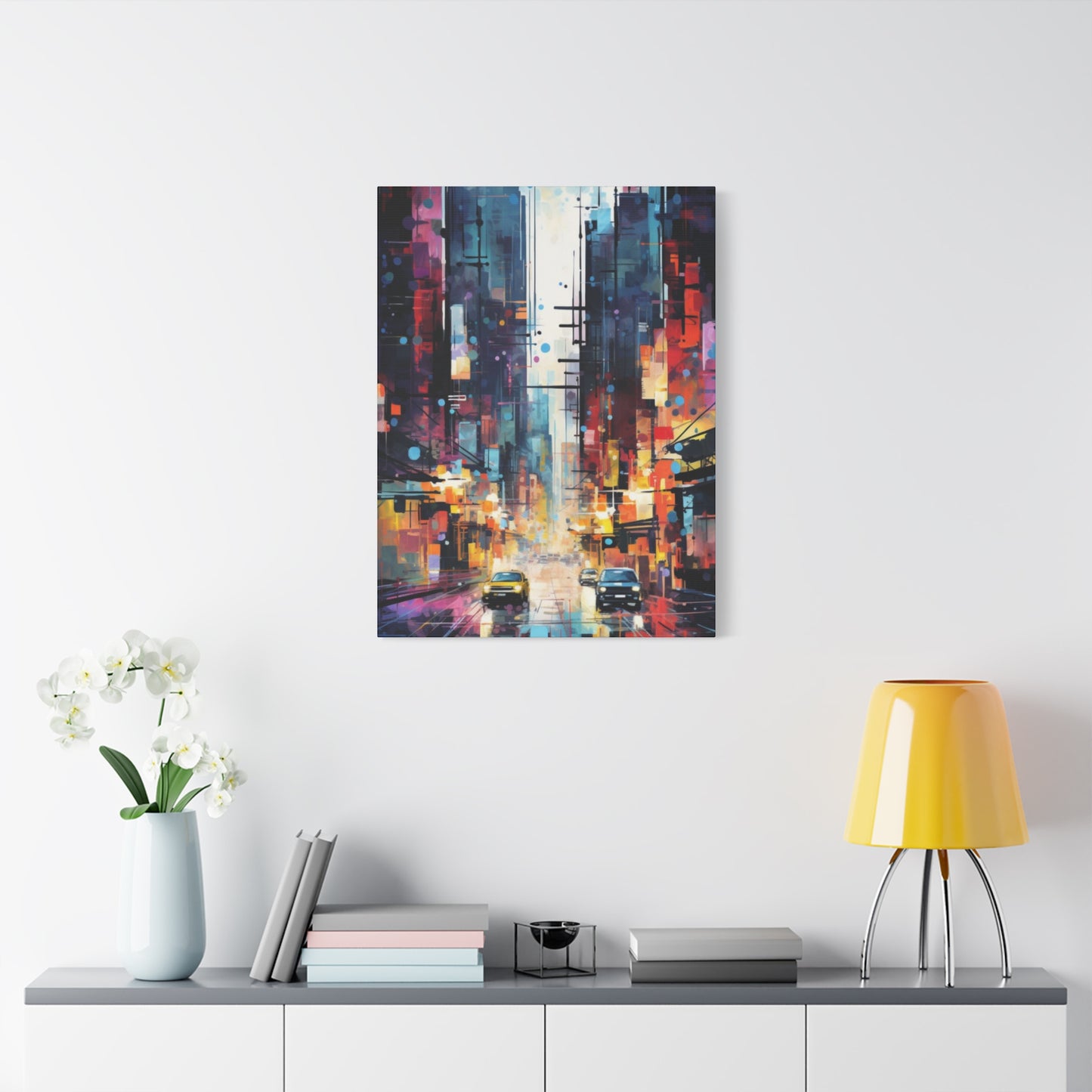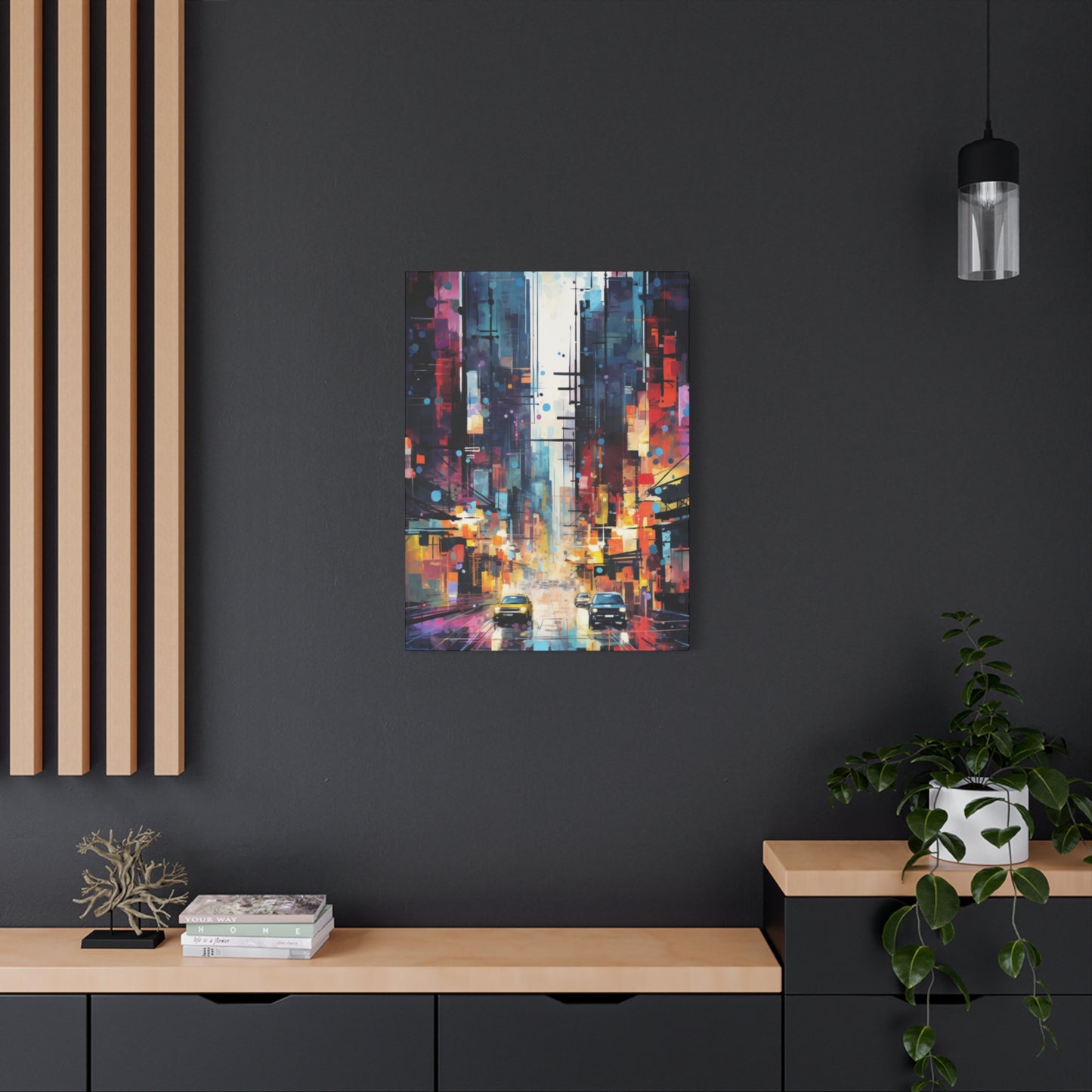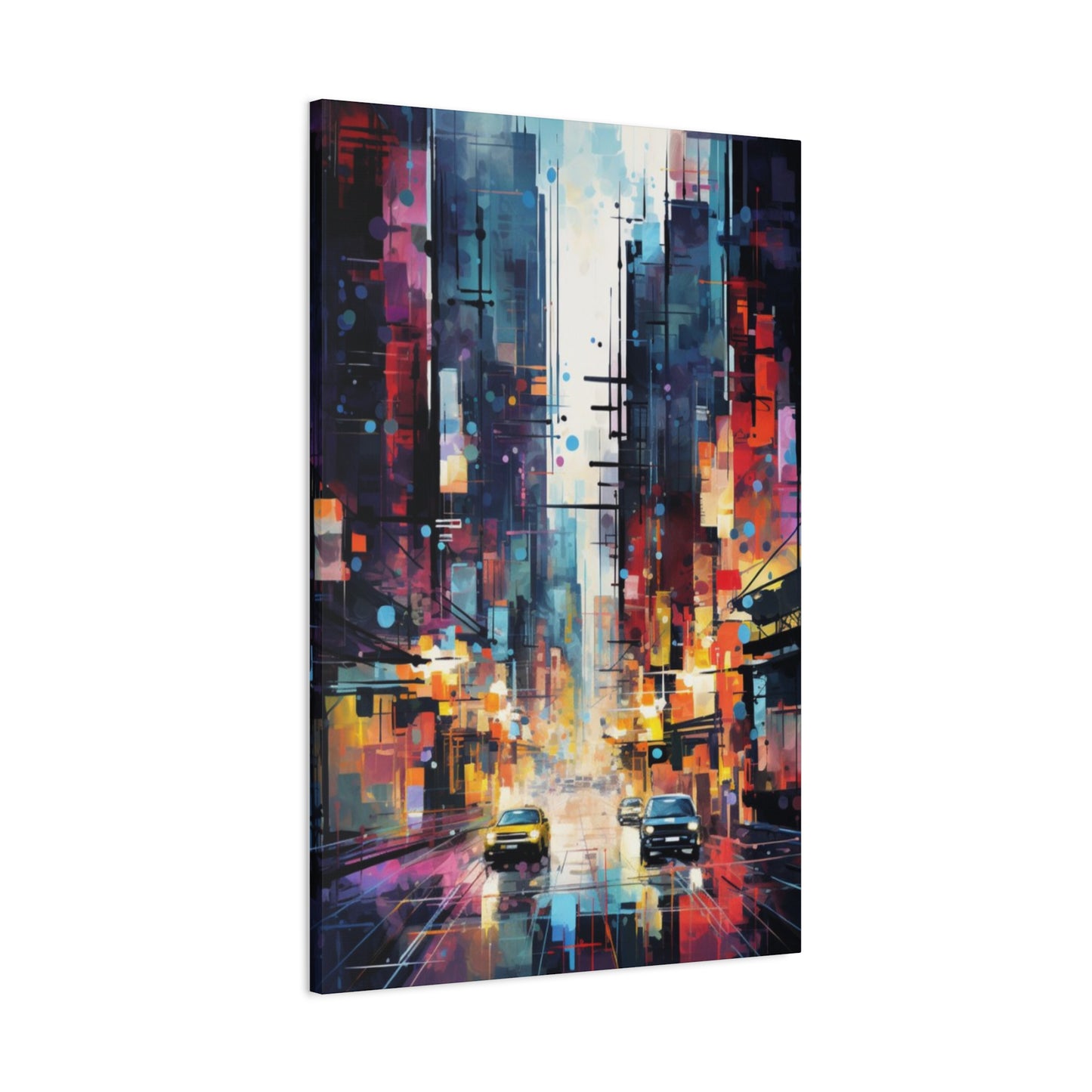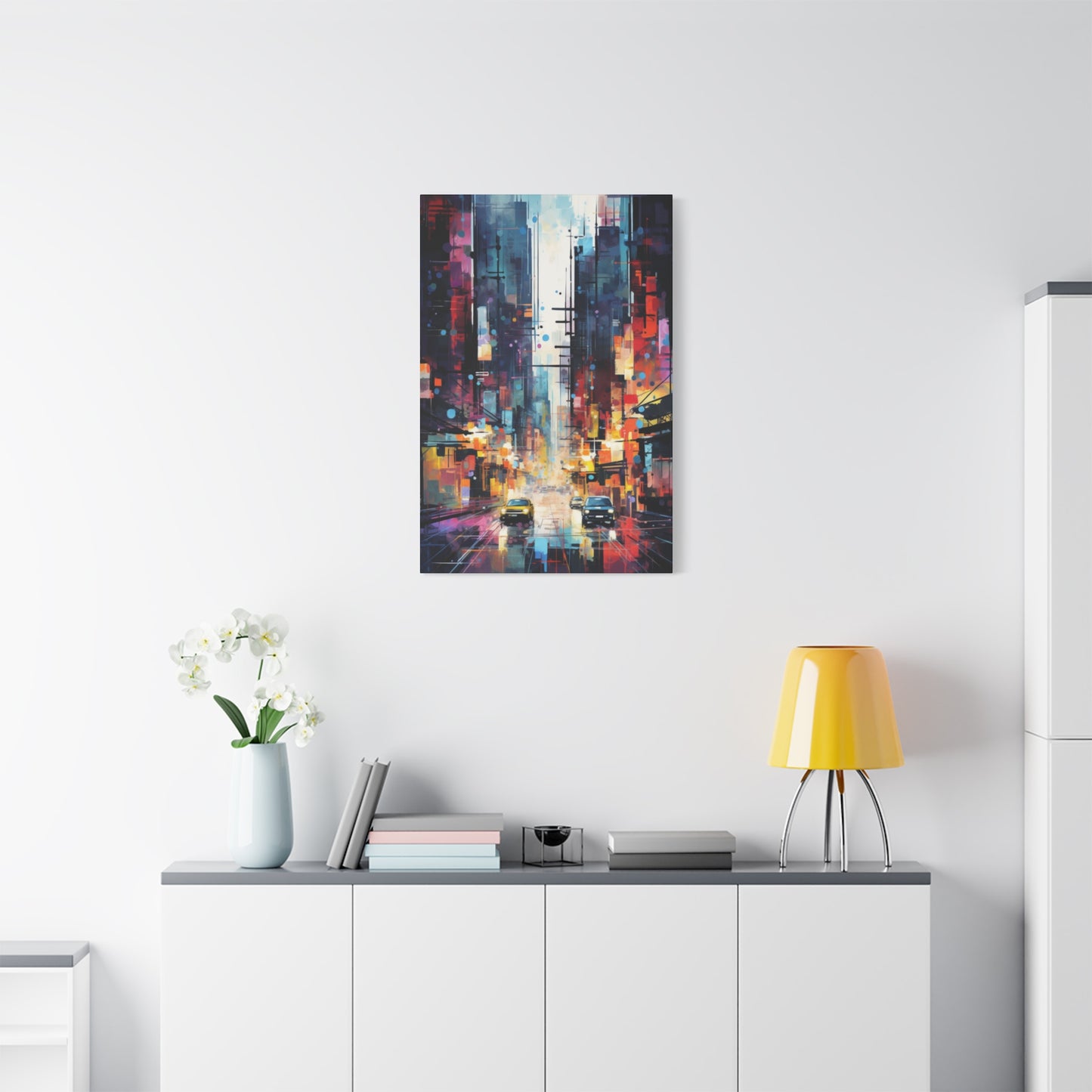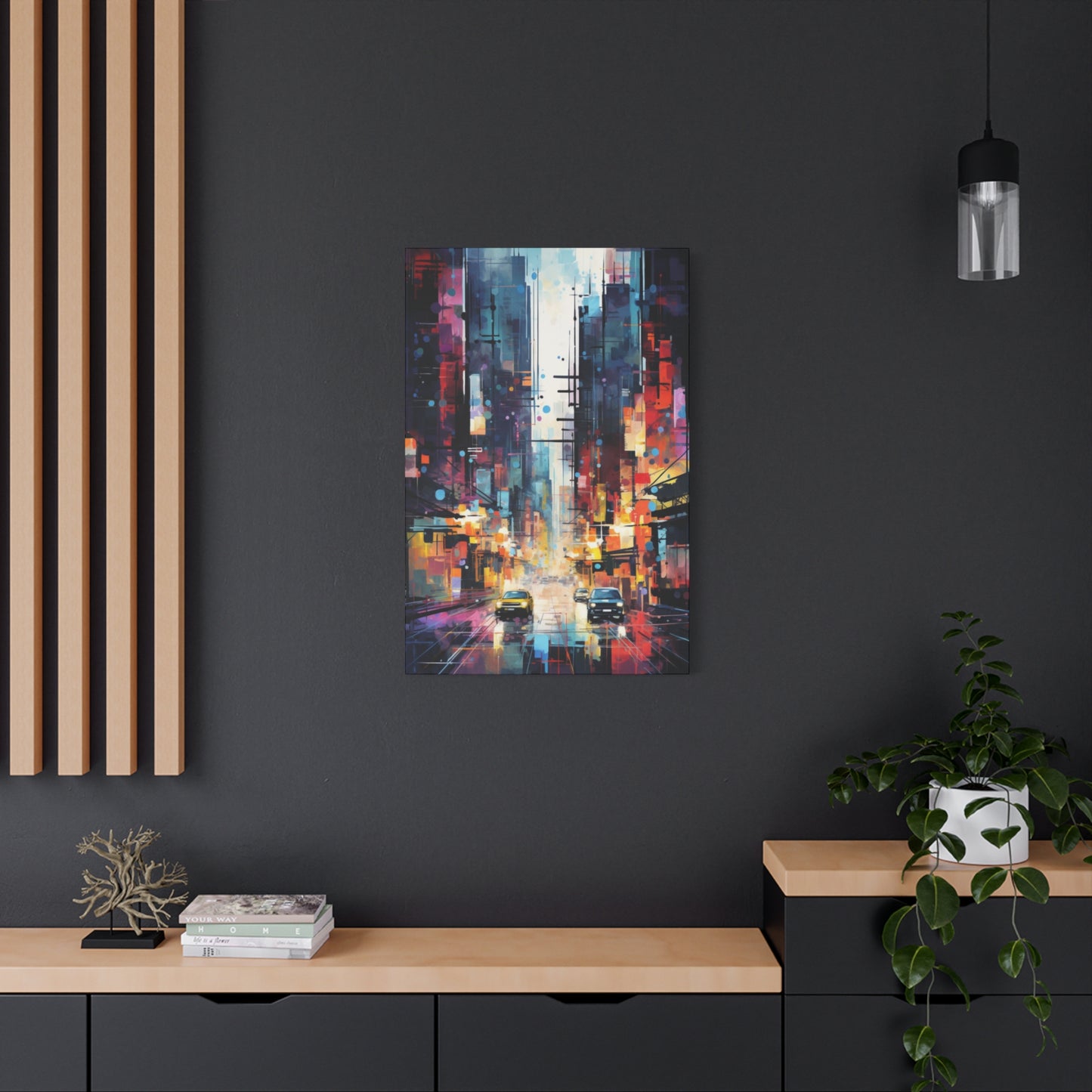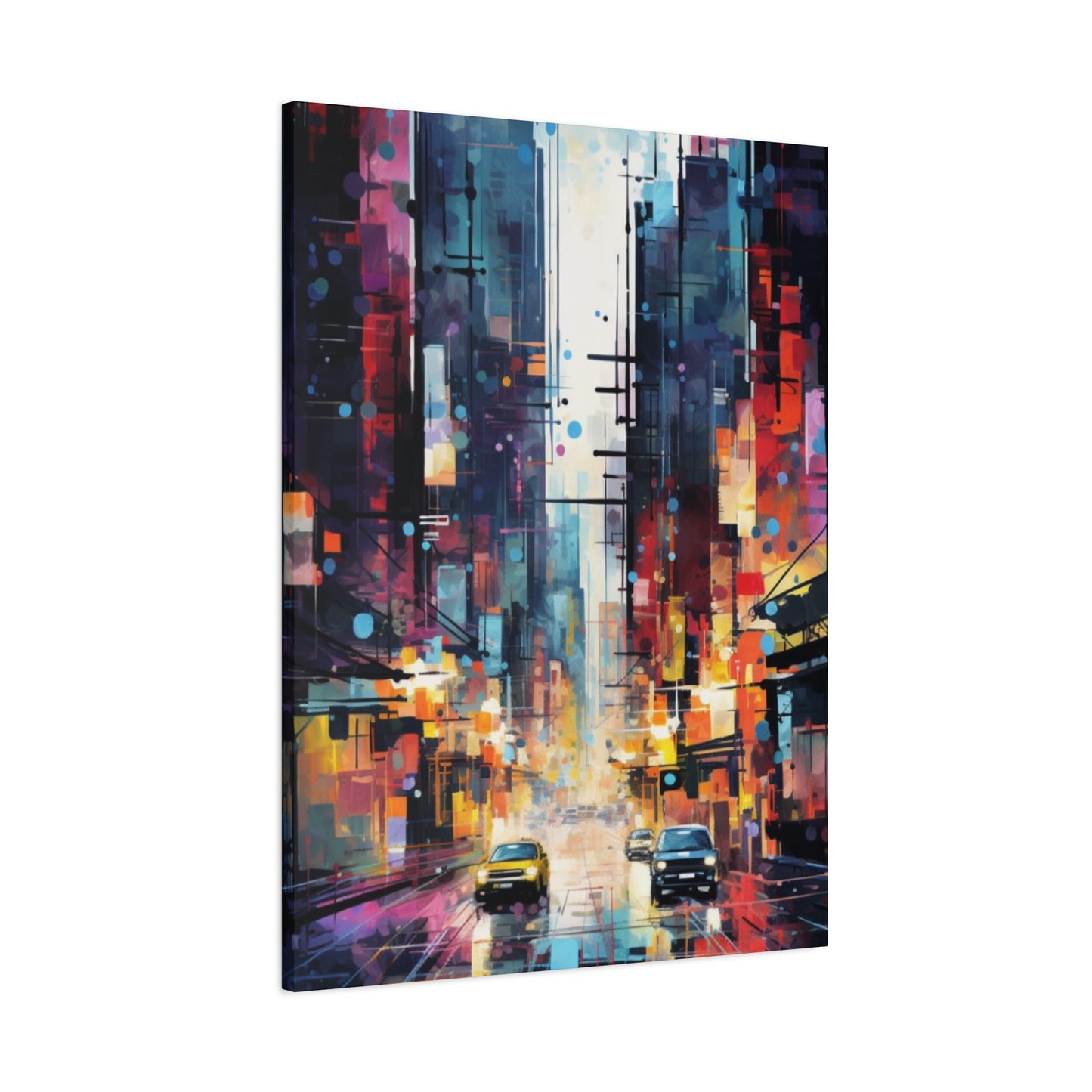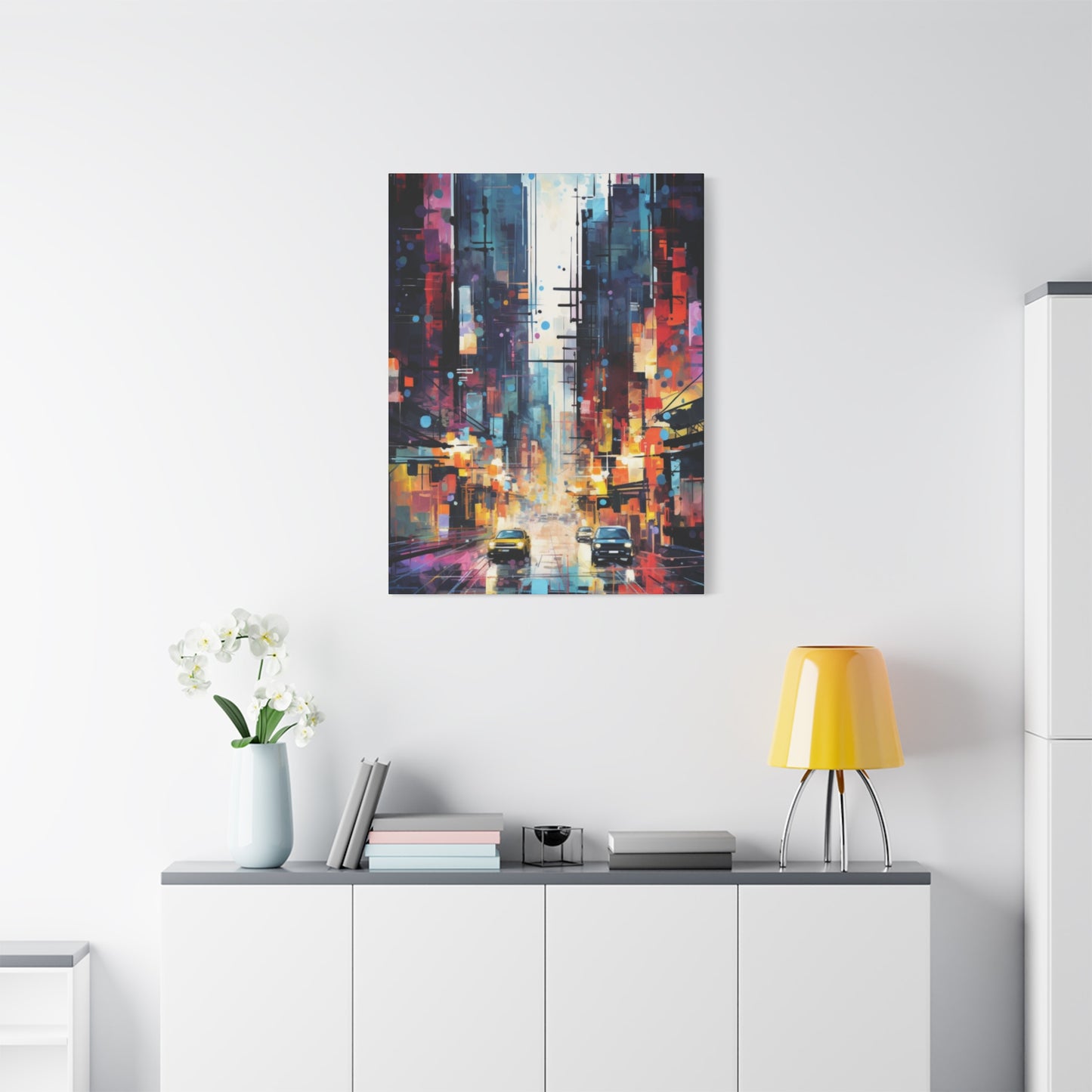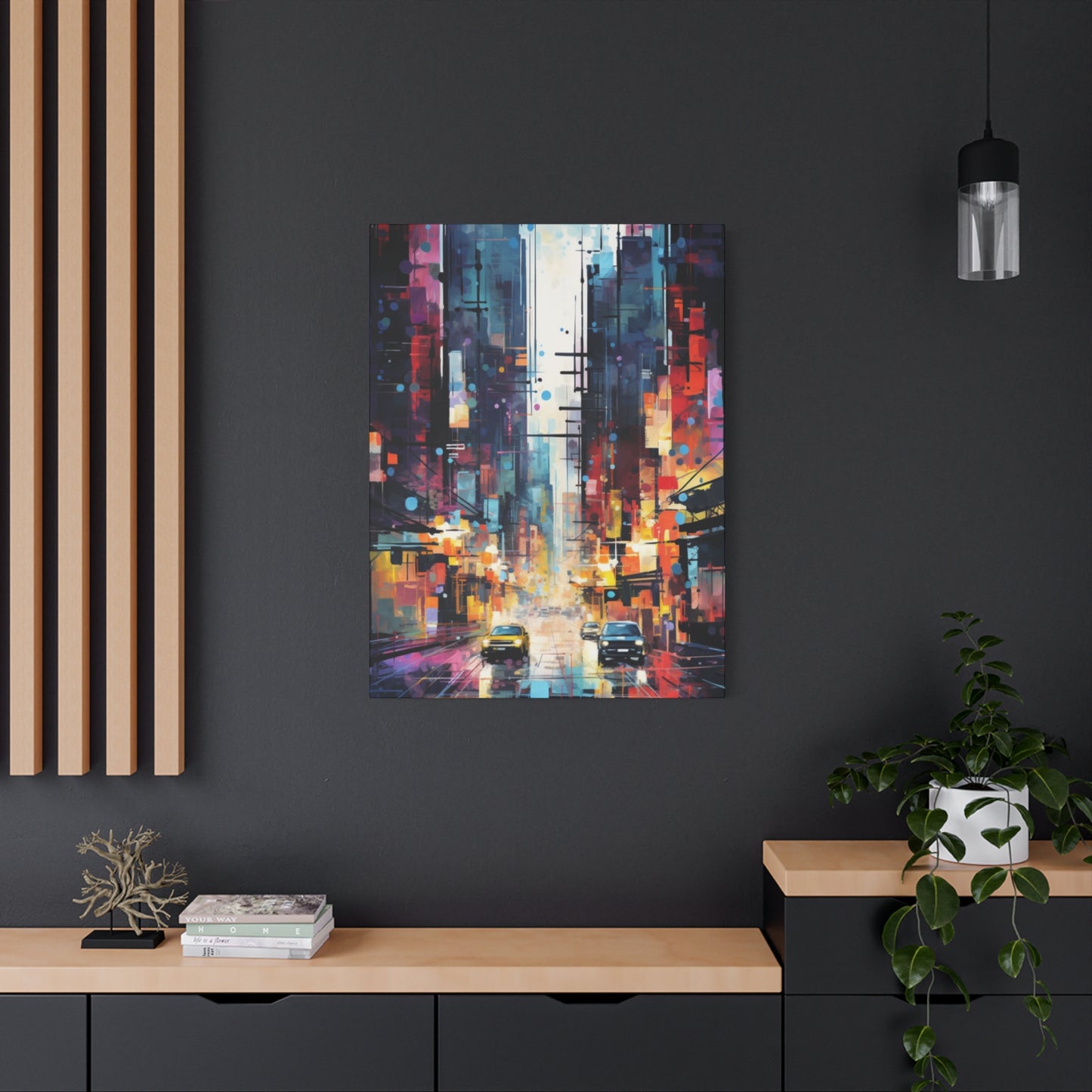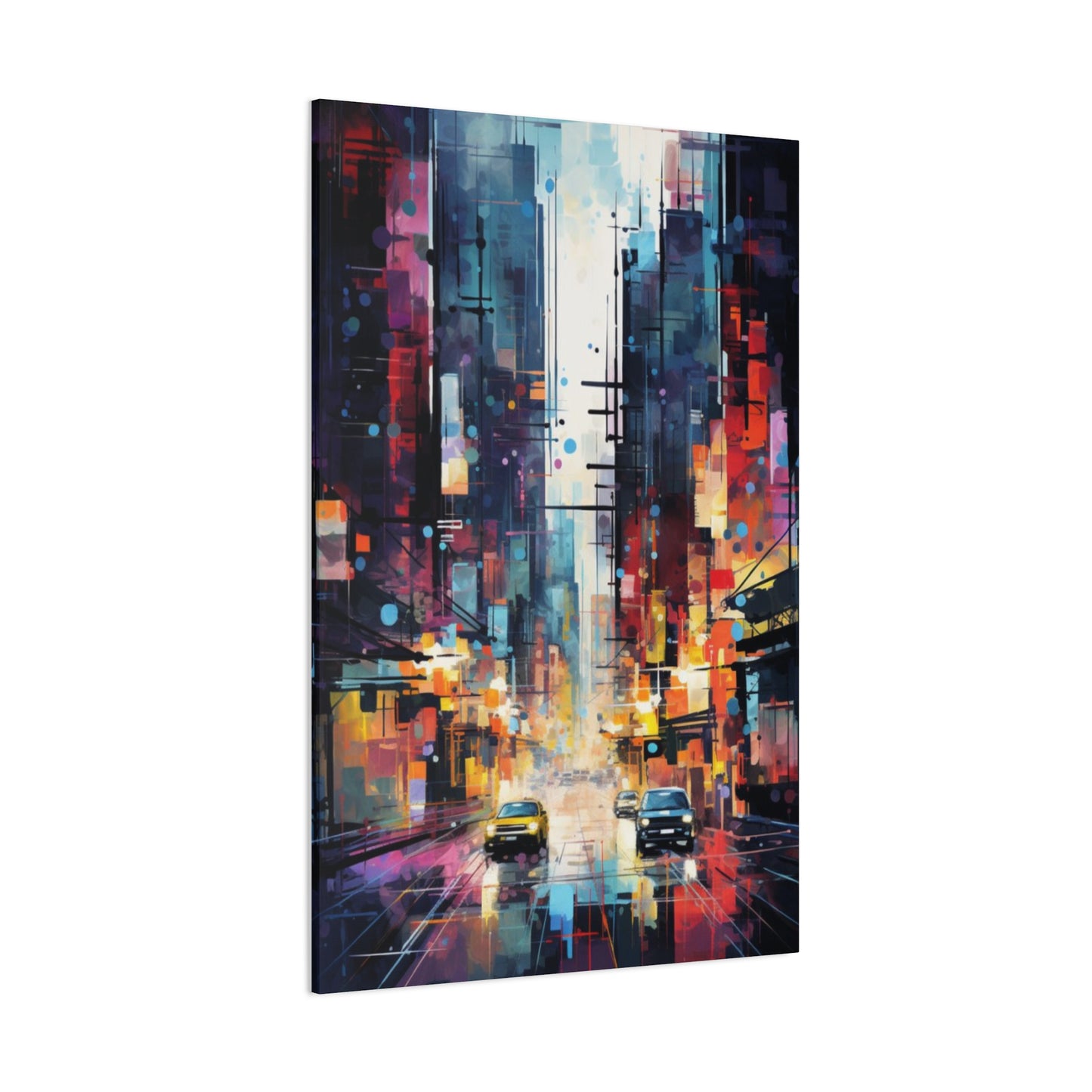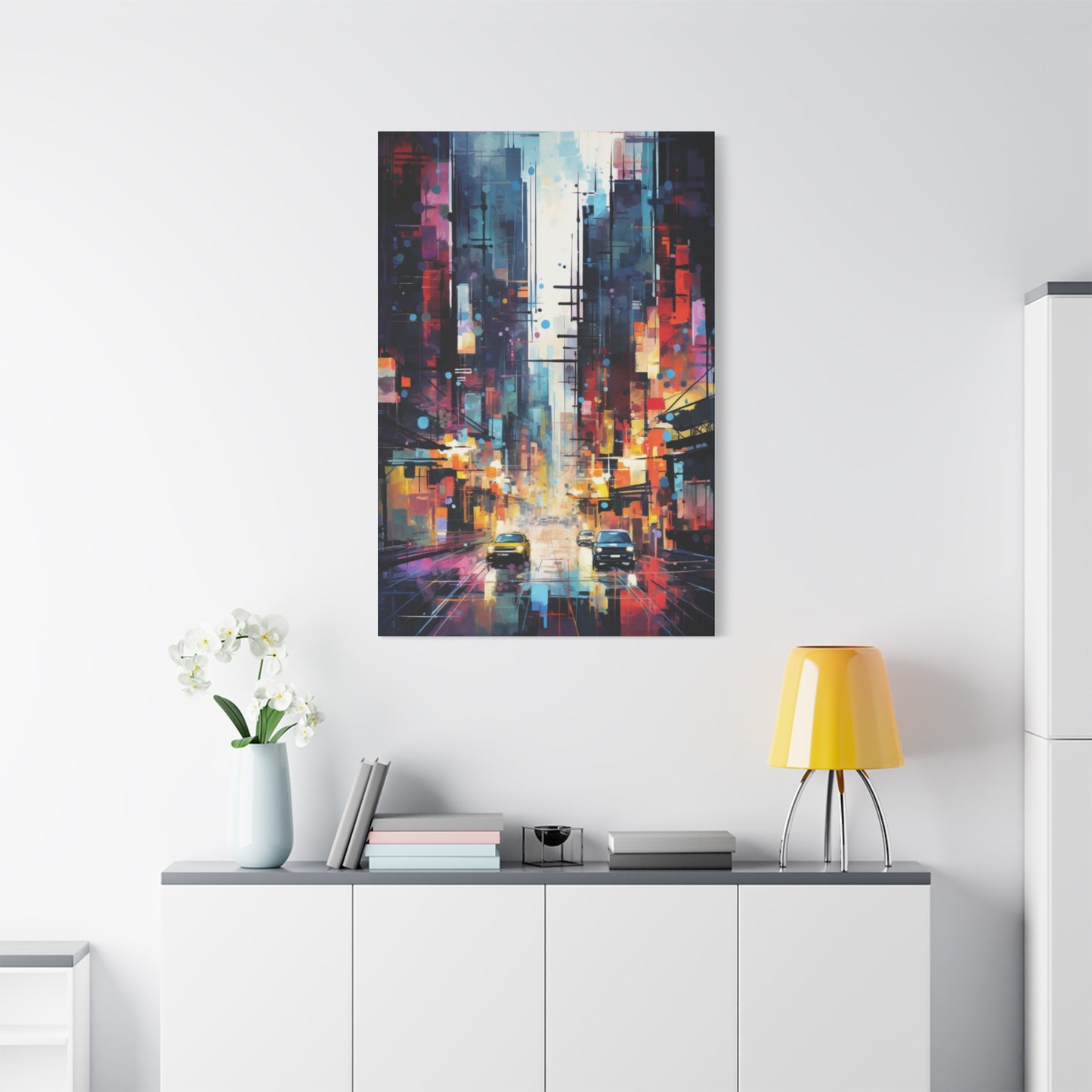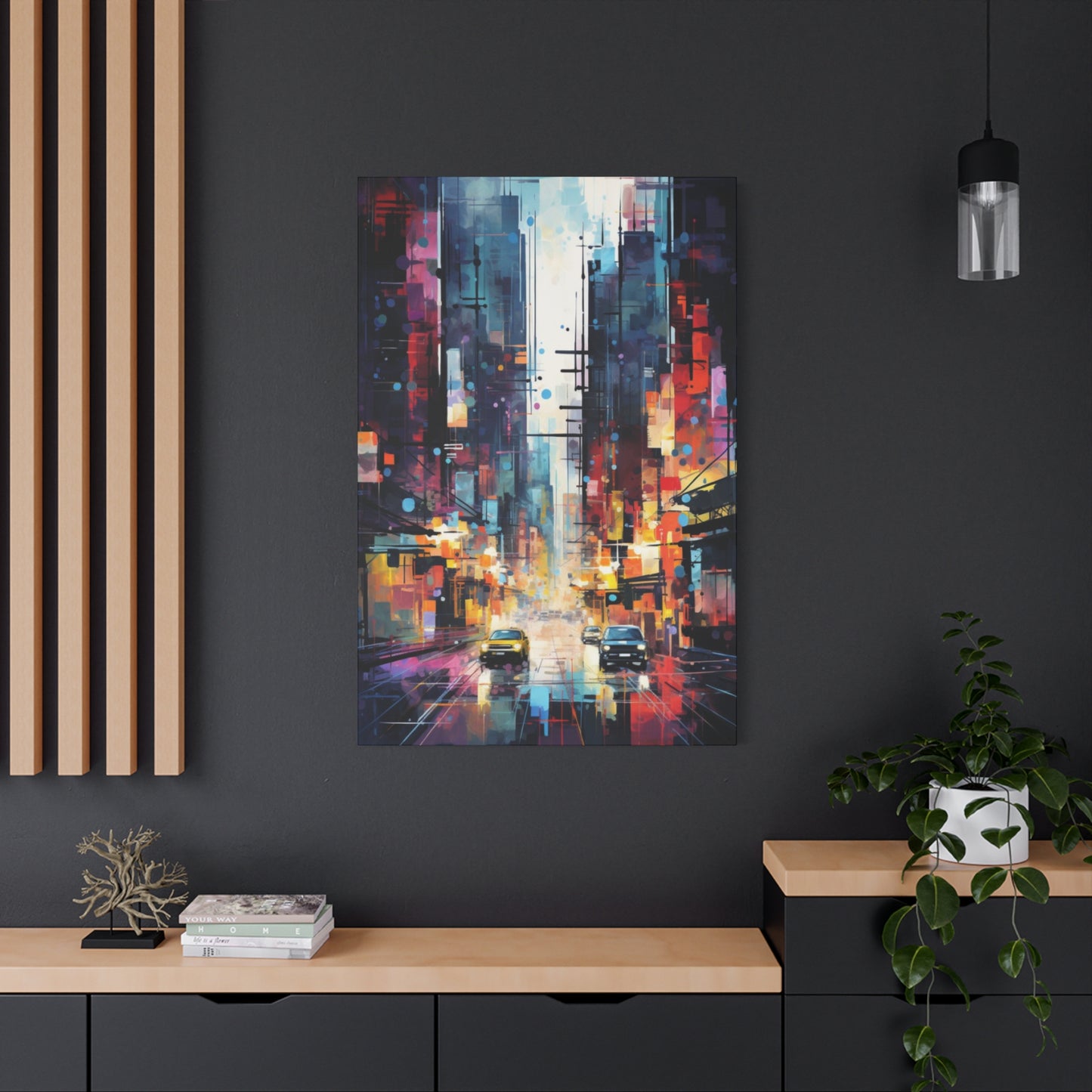Embrace Urban Romance with Raining Streets of New York City Wall Art
New York City has always been a muse for artists, photographers, and dreamers worldwide. When rain begins to fall on the bustling streets of Manhattan, Brooklyn, and beyond, the city transforms into something truly magical. The wet asphalt reflects neon lights, creating mirror-like surfaces that double the visual impact of every glowing sign and streetlight. This atmospheric beauty has captured the hearts of countless art enthusiasts who seek to bring the romantic essence of rainy New York City wall art canvas prints into their living environments.
The appeal of rain-soaked metropolitan scenes extends far beyond simple aesthetic pleasure. These artistic representations speak to something deeper within us - the urban romance, the solitary figures walking beneath umbrellas, the way light dances across wet surfaces, and the timeless quality of city life continuing regardless of weather conditions. Canvas prints featuring rainy New York streets offer viewers a window into this captivating world, allowing them to experience the city's moody atmosphere from the comfort of their own homes.
Contemporary art collectors and homeowners alike have discovered the transformative power of incorporating these evocative pieces into their living environments. The versatility of rain-themed New York City wall art canvas prints makes them suitable for various settings, from minimalist apartments to traditional family homes. The monochromatic tones often present in these pieces provide a sophisticated backdrop that complements existing decor while adding depth and character to any room.
Artistic Appeal of Rainy Metropolitan Scenes in Contemporary Home Decor
The artistic magnetism of rain-drenched city streets lies in their ability to capture fleeting moments of urban poetry. When photographers and artists document New York City during rainfall, they preserve instances where the ordinary becomes extraordinary. The interplay between natural elements and artificial constructions creates compositions that are both dramatic and intimate, bustling yet contemplative.
Canvas prints featuring these scenes bring a sense of narrative into residential environments. Each piece tells a story - perhaps of a late-night taxi ride through Times Square, pedestrians hurrying home with newspapers over their heads, or the quiet beauty of Central Park pathways glistening with fresh rainfall. These visual stories create emotional connections between viewers and their living environments, transforming ordinary walls into gateways to urban adventures.
The color palette typically found in rainy New York City wall art canvas prints tends toward sophisticated neutrals punctuated by vibrant highlights. Deep grays and blacks provide foundation tones, while golden taxi cab yellows, neon blues, and warm amber streetlight glows add dramatic accents. This color scheme naturally complements a wide range of decorating styles, from modern minimalism to classic elegance.
Professional artists who specialize in urban rain scenes understand the technical challenges involved in capturing these ephemeral moments. The reflection of light on wet surfaces requires careful attention to contrast and detail. The movement of people and vehicles through rain-soaked streets demands precise timing and composition skills. When translated to canvas prints, these technical mastery elements ensure that each piece maintains the dynamic energy and atmospheric mood of the original moment.
The emotional resonance of these artworks cannot be understated. Rain has long been associated with introspection, romance, and renewal in artistic traditions. When combined with the energetic pulse of New York City, these themes create powerful visual narratives that speak to viewers on multiple levels. The solitary figure walking through rain-slicked streets might represent independence and determination, while couples sharing umbrellas embody intimacy and partnership against urban backdrops.
Historical Context of New York City Rain Photography and Art
The tradition of documenting New York City through various weather conditions dates back to the early days of photography itself. Pioneer photographers like Alfred Stieglitz captured the city during snowstorms and rain showers, establishing a precedent for finding beauty in challenging weather conditions. These early works demonstrated that atmospheric conditions could enhance rather than hinder artistic expression.
During the mid-20th century, street photography masters such as Vivian Maier and Saul Leiter elevated rainy city scenes to new artistic heights. Leiter, in particular, became renowned for his ability to transform rain-soaked New York streets into abstract compositions filled with color and movement. His work showed how precipitation could serve as both subject matter and artistic tool, creating natural filters and reflective surfaces that added layers of visual complexity.
The emergence of color photography in the 1960s and 1970s opened new possibilities for capturing the vibrant life of New York City during rainfall. Photographers began to explore how neon signs, traffic lights, and illuminated shop windows interacted with wet surfaces to create kaleidoscopic effects. These colorful rain scenes became increasingly popular as wall art, offering viewers a more vivid representation of urban energy.
Contemporary digital photography has further expanded the possibilities for creating compelling rainy New York City wall art canvas prints. Modern cameras can capture details and colors that were previously impossible to document, while post-processing techniques allow artists to enhance atmospheric effects without compromising authenticity. High-resolution digital files ensure that canvas prints maintain exceptional quality and detail, even when produced in large formats suitable for statement wall installations.
The cultural significance of rain in New York City extends beyond mere weather documentation. Rain represents change, renewal, and the city's resilience in the face of challenges. Artists who focus on these themes often emphasize how the city's character remains unchanged despite temporary disruptions. The continued flow of pedestrian and vehicle traffic, the persistent glow of commercial signs, and the unwavering rhythm of urban life all speak to New York City's enduring spirit.
Technical Excellence in Canvas Print Production for Urban Art
The process of transforming rain-themed New York City photographs into high-quality canvas prints requires sophisticated technical expertise and attention to detail. Modern canvas printing technology has evolved significantly, allowing for reproduction quality that rivals traditional photographic prints while offering superior durability and visual impact.
Professional-grade canvas materials form the foundation of exceptional wall art. Premium cotton or polyester blend canvases provide optimal ink absorption and color retention, ensuring that the subtle gradations present in rainy street scenes are accurately reproduced. The texture of quality canvas adds tactile interest to the finished piece while maintaining the smooth tonal transitions essential for capturing the atmospheric quality of rain-soaked cityscapes.
Advanced inkjet printing systems utilize pigment-based inks that offer superior longevity and color accuracy compared to traditional dye-based alternatives. These archival-quality inks resist fading, moisture, and environmental contaminants, making them ideal for preserving the delicate balance of light and shadow present in rainy New York City wall art canvas prints. The wide color gamut available with modern printing systems ensures that even the most subtle color variations in reflected neon lights and wet asphalt are faithfully reproduced.
Pre-printing image preparation plays a crucial role in achieving optimal results. Professional print technicians carefully analyze each image to optimize contrast, saturation, and sharpness for canvas reproduction. This process takes into account the specific characteristics of canvas as a printing medium, including how the material's texture will interact with fine details and how colors will appear under various lighting conditions.
Gallery-wrap stretching techniques ensure that finished canvas prints maintain proper tension and dimensional stability over time. Professional stretcher frames constructed from kiln-dried wood provide a stable foundation that prevents warping or sagging. The gallery-wrap method extends the printed image around the edges of the frame, creating a finished appearance that eliminates the need for additional matting or framing.
Protective coating applications provide an additional layer of security for valuable wall art investments. UV-resistant varnishes or laminates shield the printed surface from harmful light exposure while maintaining the visual clarity and color vibrancy essential for appreciating the nuanced beauty of rainy cityscapes. These protective measures significantly extend the lifespan of canvas prints, ensuring that they remain vibrant and engaging for decades.
Color Psychology and Mood Enhancement Through Rainy Street Scenes
The psychological impact of color in rainy New York City wall art canvas prints extends far beyond simple aesthetic appreciation. Color psychology research has demonstrated that specific color combinations can influence mood, energy levels, and emotional well-being. The unique palette present in rain-soaked urban scenes offers particular benefits for creating positive atmospheric effects in residential environments.
Cool blue and gray tones, predominant in many rainy city scenes, are associated with tranquility, contemplation, and mental clarity. These colors can help create calming environments that promote relaxation and stress reduction. When balanced with warmer accent colors from streetlights and neon signs, the overall effect becomes energizing rather than somber, providing visual stimulation without overwhelming the senses.
The interplay between light and dark elements in rainy street photography creates natural contrast that draws the eye and maintains visual interest. High contrast imagery has been shown to stimulate cognitive function and maintain attention, making these pieces excellent choices for environments where focus and concentration are important. The dynamic range present in quality rain scenes ensures that viewers continue to discover new details and appreciate different aspects of the composition over time.
Warm yellow and amber tones from taxi cabs and street lighting provide emotional warmth that counterbalances the cooler atmospheric tones. These golden accents are psychologically associated with optimism, energy, and comfort. The strategic placement of these warmer elements within predominantly cool compositions creates visual hierarchy and emotional balance that enhances the overall viewing experience.
The reflective quality inherent in rain-soaked surfaces adds another dimension to color interaction. Reflected colors appear more saturated and vibrant than their direct counterparts, creating visual depth that engages peripheral vision and spatial perception. This enhanced dimensionality can make rooms feel larger and more dynamic, particularly when prints are positioned to take advantage of natural or artificial lighting sources.
Seasonal affective responses to rainy weather imagery can be surprisingly positive when presented in artistic contexts. While actual rain might be associated with gloomy moods, artistic representations of rain often evoke feelings of coziness, intimacy, and romantic atmosphere. This psychological distinction allows viewers to enjoy the aesthetic beauty of rainy scenes without experiencing negative emotional associations.
Selecting Appropriate Sizes for Maximum Visual Impact
Choosing the correct dimensions for rainy New York City wall art canvas prints requires careful consideration of viewing distance, room proportions, and intended visual impact. The size of artwork significantly influences how viewers perceive and interact with the piece, making this decision crucial for achieving desired atmospheric effects.
Large-format prints measuring 40 inches or more in width create immersive viewing experiences that transport viewers into the scene. These statement pieces work particularly well in rooms with high ceilings and ample wall area, such as living rooms, dining areas, or master bedrooms. The generous scale allows for appreciation of fine details present in rain-soaked street scenes while maintaining visual impact from various viewing distances.
Medium-sized prints ranging from 24 to 36 inches offer versatility and adaptability to various room configurations. These dimensions provide sufficient detail resolution for close viewing while remaining appropriate for smaller residential environments. Medium-format rain-themed urban art works well in hallways, bedrooms, home offices, or as part of gallery wall arrangements combining multiple complementary pieces.
Small-format prints under 24 inches serve specific design purposes and can be highly effective when used strategically. These intimate pieces work well in powder rooms, reading nooks, or as part of larger artistic compositions. The smaller scale encourages closer viewing, allowing appreciation of subtle details and artistic techniques that might be overlooked in larger formats.
Multi-panel arrangements offer unique opportunities for creating dramatic wall installations with rainy New York City themes. Triptych or multi-panel compositions can tell visual stories across multiple canvases, perhaps showing the progression of a rainstorm or different perspectives of the same street scene. These arrangements allow for creative flexibility in accommodating various wall dimensions while maintaining cohesive artistic impact.
Proportional relationships between artwork and furniture should be carefully considered when selecting canvas print sizes. General design principles suggest that wall art should be approximately two-thirds the width of furniture pieces below it, such as sofas or dining tables. However, these guidelines can be adjusted based on personal preferences and specific atmospheric goals for each room.
Framing Options and Presentation Methods for Professional Results
While canvas prints offer inherent structural integrity through their stretched mounting system, additional framing options can enhance their visual presentation and protect the investment for long-term enjoyment. Professional presentation methods ensure that rainy New York City wall art canvas prints achieve maximum aesthetic impact while maintaining their condition over time.
Gallery-wrapped canvas prints represent the most popular contemporary presentation method, offering clean, modern aesthetics that complement various decorating styles. This frameless approach allows the artwork to appear as if it floats on the wall, creating an uninterrupted visual experience that draws attention to the rain-soaked urban scenes rather than decorative borders. The wrapped edges can either continue the image around the sides or feature solid colors that complement the primary composition.
Traditional framing with matting provides classical presentation that works well in formal or traditional residential settings. Custom matting in neutral tones can enhance the sophisticated color palette present in rainy street scenes while providing visual breathing room around the central image. Professional framing also offers superior protection against environmental factors and handling damage.
Floating frame systems combine the modern appeal of gallery-wrapped presentation with the protective benefits of traditional framing. These systems suspend the canvas within a frame structure, creating shadow gaps that add dimensional interest while maintaining the contemporary aesthetic. Floating frames work particularly well with rain-themed urban art because the dimensional effect mimics the layered depth present in wet street reflections.
Metal frame options provide industrial aesthetics that complement the urban subject matter of New York City street scenes. Brushed aluminum, steel, or black metal frames enhance the metropolitan character of rainy cityscapes while providing contemporary sophistication. These frames work particularly well in modern or minimalist decorating schemes where clean lines and industrial materials are featured prominently.
Acrylic mounting systems offer ultra-modern presentation that creates impressive dimensional effects. Face-mounting techniques place the image between acrylic panels, creating depth and enhancing color vibrancy while providing superior protection. These high-end presentation methods work well with dramatic rain scenes because the acrylic surface mimics the reflective quality of wet city streets.
Lighting Considerations for Optimal Display of Rain-Themed Urban Art
Proper illumination plays a crucial role in maximizing the visual impact and atmospheric qualities of rainy New York City wall art canvas prints. The interaction between artificial lighting and rain-themed imagery can either enhance or diminish the moody, atmospheric qualities that make these pieces so compelling.
Natural lighting considerations should be primary factors when positioning rain-themed urban art. North-facing walls typically receive consistent, indirect natural light that prevents harsh shadows or glare while maintaining color accuracy throughout the day. This stable lighting condition works particularly well with the subtle tonal variations present in rainy street scenes, allowing viewers to appreciate delicate gradations without interference from changing light conditions.
Artificial lighting systems designed specifically for artwork provide optimal illumination control and color rendering. LED picture lights with adjustable color temperature allow customization of lighting warmth to enhance either the cool atmospheric tones or warm accent colors present in rain-soaked cityscapes. Professional-grade LED systems also minimize heat generation, protecting valuable canvas prints from thermal damage.
Track lighting systems offer flexibility for illuminating multiple pieces or adjusting light direction as needed. Adjustable spotlights can be positioned to graze across canvas surfaces, enhancing texture and dimensional qualities while minimizing glare. The directional control available with track systems allows for dramatic lighting effects that can emphasize specific elements within rain-themed compositions.
Ambient lighting integration ensures that wall art remains visible and engaging during various daily activities and evening hours. Dimmer controls allow adjustment of lighting intensity to create appropriate moods for different occasions while preventing overexposure that might damage sensitive pigments. Properly integrated ambient lighting makes rain-themed urban art an active part of daily living rather than merely decorative objects.
Avoiding problematic lighting conditions protects both the artwork and viewing experience. Direct sunlight can cause fading and heat damage to canvas prints, while harsh fluorescent lighting can create unflattering color casts that diminish the sophisticated palette of rainy cityscapes. Positioning artwork away from heat sources such as fireplaces, radiators, or heating vents prevents thermal damage and dimensional instability.
Complementary Decor Elements for Cohesive Room Design
Creating harmonious residential environments with rainy New York City wall art canvas prints requires thoughtful integration of complementary decorative elements. The sophisticated urban aesthetic of rain-themed artwork provides an excellent foundation for developing cohesive room designs that reflect both cosmopolitan sophistication and personal style preferences.
Furniture selections should enhance rather than compete with the atmospheric qualities of rainy street art. Clean-lined contemporary pieces in neutral tones allow the artwork to serve as the primary focal point while providing functional support for daily activities. Materials such as brushed metal, glass, and leather echo the urban themes present in city rain scenes while maintaining sophisticated elegance.
Textile choices play important roles in reinforcing the mood and color palette established by rain-themed wall art. Soft furnishings in coordinating grays, blues, and warm accent colors create visual continuity throughout the room while providing comfort and texture contrast to hard surfaces. Fabrics with subtle patterns or textures can echo the visual complexity of rain-soaked streets without overwhelming the primary artistic statement.
Lighting fixtures should complement both the artwork and overall room design while providing functional illumination for various activities. Industrial-inspired pendant lights, sleek table lamps, or architectural floor lighting can reinforce the urban themes while serving practical purposes. The warm glow from carefully selected lighting creates atmosphere that enhances the moody quality of rainy cityscapes.
Accessory placement requires careful consideration to maintain visual balance and prevent clutter that might detract from the primary artwork. Strategic placement of books, plants, or sculptural objects can create visual interest while supporting the sophisticated urban aesthetic. Metallic accents in silver, gold, or copper can echo the reflective qualities present in rain-soaked street scenes.
Color coordination throughout the room should reinforce the palette established by the rain-themed artwork while allowing for personal expression through accent pieces. Paint colors, upholstery selections, and decorative objects should work together to create cohesive environments that feel intentional rather than accidentally assembled.
Seasonal Decorating with Rain-Themed Metropolitan Art
The versatility of rainy New York City wall art canvas prints extends throughout the seasonal cycle, offering opportunities to refresh and revitalize room aesthetics while maintaining consistent artistic quality. Understanding how to adapt decorating approaches for different seasons ensures that rain-themed urban art remains engaging and relevant throughout the year.
Spring decorating can emphasize the renewal and growth themes inherent in rainfall while incorporating fresh colors and lighter textures. The cool tones present in rainy street scenes provide excellent foundations for introducing soft pastels through flowers, pillows, or lightweight throws. The connection between rain and new growth makes this seasonal approach particularly meaningful and visually coherent.
Summer adaptations might focus on the cooling, refreshing qualities of rain-themed artwork during warmer months. The psychological cooling effect of blue and gray tones can help create comfortable environments even when outdoor temperatures rise. Lighter window treatments and minimal accessory approaches allow the sophisticated urban art to provide visual interest without adding psychological warmth to the environment.
Autumn decorating naturally complements the moody, contemplative qualities of rainy cityscapes. Rich warm tones from seasonal foliage can be introduced through textile changes, decorative objects, or floral arrangements that echo the amber street lighting present in urban rain scenes. This seasonal approach creates cozy, intimate environments perfect for cooler weather and shorter daylight hours.
Winter presentations can emphasize the dramatic contrast and sophisticated color palette inherent in rain-themed urban art. The monochromatic qualities of many rain scenes work beautifully with winter's natural color restrictions while providing visual warmth through artificial lighting and strategic accent colors. This approach creates elegant, refined environments suitable for formal entertaining and intimate gatherings.
Year-round consistency can be achieved by focusing on the timeless qualities of urban rain themes rather than seasonal adaptations. The classic sophistication of well-executed rain-soaked street scenes transcends seasonal changes, providing stable visual anchors that support various decorating approaches throughout the annual cycle.
Investment Value and Long-Term Appreciation Potential
High-quality rainy New York City wall art canvas prints represent significant investment opportunities for collectors and homeowners who appreciate both aesthetic value and potential financial appreciation. Understanding the factors that influence long-term value helps inform purchasing decisions and collection development strategies.
Artist reputation and recognition play primary roles in determining investment potential for urban rain-themed artwork. Photographers and artists who have established reputations for excellence in street photography or urban documentation typically see their works appreciate over time. Limited edition prints by recognized artists often show stronger investment performance than mass-produced alternatives.
Print quality and production methods significantly influence long-term value retention and appreciation potential. Professional-grade canvas prints using archival materials and pigment-based inks maintain their visual quality for decades, ensuring that the investment remains aesthetically appealing over time. Poor-quality reproductions may deteriorate rapidly, eliminating both aesthetic and financial value.
Market demand for urban rain-themed artwork has shown consistent strength as metropolitan aesthetics become increasingly popular in residential design. The emotional appeal of rainy New York City scenes, combined with their decorative versatility, ensures continued interest from collectors and decorators. This sustained demand supports stable or increasing values for quality pieces.
Rarity and edition limitations can enhance investment potential for exceptional rain-themed urban art. Numbered limited editions or unique printing techniques create scarcity that can drive appreciation among serious collectors. However, the primary focus should remain on aesthetic quality and personal enjoyment rather than purely financial considerations.
Proper care and maintenance preserve both aesthetic and investment value over time. Professional installation, appropriate lighting conditions, and regular maintenance ensure that canvas prints retain their original visual impact. Well-maintained pieces typically show better value retention than those that have been exposed to damaging conditions or poor handling practices.
Customization Options for Personalized Urban Art Experiences
Modern printing technology and artistic services offer extensive customization opportunities for creating personalized rainy New York City wall art canvas prints that reflect individual preferences and specific decorating requirements. These customization options ensure that each piece perfectly suits its intended environment while maintaining artistic integrity and visual impact.
Size customization allows for precise fitting to available wall dimensions and specific design requirements. Professional printing services can produce canvas prints in virtually any dimension, from intimate small-format pieces suitable for powder rooms to large-scale installations designed for commercial or residential statement walls. Custom sizing ensures optimal visual proportions and maximum impact within specific architectural contexts.
Color adjustment services enable modification of hue, saturation, and tonal balance to complement existing room color schemes or personal preferences. Professional color correction can enhance specific aspects of rain-soaked street scenes, such as emphasizing warm streetlight glows or intensifying the dramatic contrast between wet pavement and illuminated signs. These modifications maintain artistic authenticity while optimizing visual harmony with surrounding decor.
Cropping and composition modifications allow focus on specific elements within larger photographic compositions. A dramatic rain scene might be cropped to emphasize particular architectural details, street-level activity, or atmospheric effects that best suit the intended installation location. Professional cropping services ensure that modified compositions maintain visual balance and artistic integrity.
Multiple format options provide flexibility for creating cohesive installations using variations of the same basic image. A single rain-themed photograph might be adapted into vertical, horizontal, and square formats for use in different room configurations or as part of gallery wall arrangements. Consistent source material ensures visual harmony while providing installation versatility.
Personalized color palette development can adapt rain-themed urban scenes to coordinate with specific decorating schemes or architectural features. Professional artists can modify the color balance of existing photographs or create entirely new interpretations that maintain the essential character of rainy New York City while incorporating colors that complement particular residential environments.
Care and Maintenance Guidelines for Canvas Print Longevity
Proper maintenance and care practices ensure that rainy New York City wall art canvas prints maintain their visual quality and structural integrity for decades of enjoyment. Understanding the specific requirements of canvas materials and printing technologies helps protect these valuable decorative investments.
Regular dusting using appropriate tools and techniques prevents accumulation of airborne particles that can dull surface appearance and potentially cause long-term damage. Soft microfiber cloths or professional art cleaning brushes remove dust without scratching delicate printed surfaces. Dusting should be performed gently, following the direction of canvas weave to avoid disturbing the printed image.
Environmental control plays crucial roles in preserving canvas prints over extended periods. Maintaining stable temperature and humidity levels prevents dimensional changes that can cause cracking, warping, or separation of printed layers. Relative humidity between 45-55% and temperatures between 65-75°F provide optimal conditions for long-term preservation.
Light exposure management protects valuable pigments from fading and degradation over time. While modern archival inks offer excellent lightfastness, minimizing direct sunlight exposure and using UV-filtering glazing materials provides additional protection. LED lighting systems with appropriate color temperature and intensity settings allow appreciation without causing cumulative damage.
Professional cleaning services should be employed when canvas prints require more than routine dusting. Specialized art conservation techniques and materials ensure safe removal of stains, accumulated grime, or other contaminants without damaging the printed surface or canvas substrate. Attempting amateur cleaning of valuable artwork can result in permanent damage and loss of investment value.
Storage considerations become important when canvas prints must be temporarily removed from display or transported to new locations. Professional packing materials and techniques protect against physical damage, moisture exposure, and temperature fluctuations during storage or shipping. Proper storage ensures that artwork remains in pristine condition for future display.
Cultural Significance of Rain in Urban Photography
The artistic tradition of documenting rainfall in urban environments carries deep cultural meanings that extend far beyond simple weather documentation. Rain serves as a powerful metaphor for transformation, renewal, and the persistent human spirit that continues to thrive despite challenging conditions.
In photographic contexts, rain creates opportunities for exploring themes of isolation and community, showing how adverse weather can both separate individuals and bring them together under shared experiences. The solitary figure walking through rain-soaked streets might represent independence and determination, while groups huddled under shop awnings demonstrate human connection and mutual support.
The transformation of familiar urban landscapes through rainfall reveals hidden beauty in everyday environments. Ordinary streets become mirror-like galleries reflecting neon signs, traffic lights, and architectural details in ways that are impossible during dry conditions. This transformation encourages viewers to see their own environments with fresh perspectives and greater appreciation for transient beauty.
Rain-themed urban photography often captures the contrast between natural and artificial elements, highlighting humanity's relationship with both the built environment and natural forces. The interplay between falling rain and electric lighting, between organic water patterns and geometric architecture, creates visual metaphors for the complex relationships between nature and human civilization.
The emotional resonance of rain in urban contexts draws from literary and cinematic traditions that have established rain as a symbol for romance, melancholy, renewal, and dramatic tension. These cultural associations enhance the viewing experience by triggering subconscious emotional responses that deepen engagement with the artwork.
Contemporary urban rain photography continues this cultural tradition while incorporating modern themes such as climate change, urban density, and technological integration into daily life. Current artists working in this genre often explore how precipitation interacts with electronic displays, modern materials, and contemporary architectural forms to create new visual vocabularies.
Regional Variations in New York City Rain Photography
The diverse neighborhoods and boroughs of New York City offer distinctly different aesthetic opportunities for rain-themed photography, each contributing unique character and visual elements to the overall tradition of urban precipitation documentation. Understanding these regional variations helps collectors and enthusiasts appreciate the full spectrum of rain-themed New York City wall art canvas prints.
Manhattan rain scenes often emphasize the dramatic vertical elements of skyscrapers reflected in wet streets, creating canyon-like compositions where rain appears to fall between towering walls of glass and steel. The density of neon signage and commercial lighting in areas like Times Square, Broadway, and Midtown creates particularly vibrant rain photography opportunities with intense color saturation and multiple reflection layers.
Brooklyn rain photography frequently captures more intimate neighborhood scenes where brownstone architecture and tree-lined streets create different atmospheric effects. The lower building heights allow for more sky to appear in compositions, showing actual rainfall and cloud formations rather than just their ground-level effects. Brooklyn's industrial areas also provide opportunities for rain scenes featuring warehouses, bridges, and waterfront elements.
Queens rain photography often incorporates the borough's diverse architectural styles and cultural influences, showing how precipitation affects various ethnic neighborhoods and commercial districts. The mix of residential and commercial areas creates opportunities for rain scenes that emphasize community life and the way different cultural groups respond to weather challenges.
The Bronx offers rain photography opportunities that combine urban elements with more extensive green spaces, showing how precipitation affects both built environments and natural areas within the city. The borough's bridges and waterfront areas provide dramatic backdrops for rain scenes that emphasize the relationship between urban development and natural waterways.
Staten Island rain photography might focus more on suburban and residential themes while maintaining connections to the broader New York metropolitan area. The borough's ferry connections to Manhattan create opportunities for rain scenes that bridge different urban experiences and architectural styles.
Color Theory Applications in Rain-Soaked Street Art
The sophisticated color relationships present in rainy New York City wall art canvas prints demonstrate advanced color theory principles that contribute significantly to their aesthetic appeal and emotional impact. Understanding these color interactions helps viewers appreciate the technical mastery required to create compelling rain-themed urban art.
Complementary color relationships between cool blue-gray atmospheric tones and warm yellow-orange streetlight colors create visual tension and energy that prevents rain scenes from appearing monotonous or depressing. These opposing colors on the color wheel naturally attract attention and create vibrant contrast even within predominantly neutral compositions.
Analogous color harmonies within the cool portion of the color spectrum - blues, blue-grays, and blue-greens - provide sophisticated unity while maintaining visual interest through subtle variations in hue and saturation. These closely related colors create calming, cohesive effects that work well in residential environments where tranquility and relaxation are desired.
Monochromatic color schemes using various values and saturations of gray create dramatic, sophisticated effects that emphasize form, texture, and composition over color relationships. These approaches work particularly well for rain scenes where the absence of bright color allows viewers to focus on the interplay between light and shadow, reflection and absorption.
Color temperature contrasts between warm artificial lighting and cool natural rainfall create psychological depth and emotional complexity. Warm colors advance visually while cool colors recede, creating natural depth effects that enhance the three-dimensional quality of two-dimensional canvas prints. This temperature contrast also reinforces the distinction between human-created warmth and natural atmospheric conditions.
Saturation variations throughout rain-themed compositions guide viewer attention and create visual hierarchy. Highly saturated accent colors in neon signs or taxi cabs attract immediate attention, while desaturated background tones provide context without competing for visual dominance. This careful balance of saturation levels creates compositions that remain engaging without becoming overwhelming.
Photography Techniques for Capturing Urban Rain Scenes
The technical challenges of photographing rain in urban environments require specialized knowledge and equipment to achieve the dramatic effects seen in high-quality canvas prints. Understanding these techniques helps viewers appreciate the skill and dedication required to create compelling rain-themed New York City wall art.
Shutter speed selection plays crucial roles in determining how falling rain appears in final images. Fast shutter speeds freeze individual raindrops in mid-air, creating sharp linear elements that add texture and energy to compositions. Slower shutter speeds allow rain to streak, creating soft vertical lines that suggest movement and intensity while maintaining sharp focus on static elements like buildings and streets.
Aperture choices affect depth of field and determine which elements of rain-soaked scenes remain in sharp focus. Wide apertures create shallow depth of field that can isolate specific subjects like pedestrians with umbrellas against artistically blurred backgrounds of rain-streaked lights and traffic. Narrow apertures maintain sharp focus throughout the composition, ensuring that both foreground and background elements contribute equally to the visual story.
ISO settings must balance image quality with the low-light conditions typically present during rainfall. Modern digital cameras allow higher ISO settings while maintaining acceptable image quality, enabling photographers to capture sharp images of moving subjects without resorting to flash photography that might destroy the natural atmospheric lighting.
Composition techniques for rain photography often emphasize leading lines created by wet streets, sidewalks, and reflected light patterns. These linear elements guide viewer attention through the composition while creating depth and perspective that enhance the three-dimensional quality of the scene. Strategic positioning of vertical elements like lamp posts, trees, or people creates counterpoints to horizontal lines and prevents compositions from becoming too static.
Timing considerations involve understanding how different types of precipitation create various visual effects. Light drizzle might create subtle atmospheric effects without dramatic surface reflections, while heavy downpours produce more intense reflections and greater contrast between wet and dry surfaces. The period immediately after rain stops often provides optimal conditions for reflection photography without the visual interference of actively falling precipitation.
Lighting Effects and Atmospheric Conditions in Rain Photography
The interaction between various light sources and atmospheric moisture creates the magical effects that make rainy New York City wall art canvas prints so visually compelling. Understanding these lighting phenomena helps viewers appreciate the natural and artificial elements that contribute to urban rain photography's distinctive aesthetic.
Neon sign reflections in wet pavement create double-exposure effects that amplify color intensity and create visual depth through layered imagery. The smooth surfaces of rain-soaked streets act as imperfect mirrors that reflect colored light while allowing some penetration, creating effects that are more complex and interesting than simple mirror reflections. These multi-layered light interactions produce the rich color saturation characteristic of high-quality urban rain photography.
Street lamp illumination through atmospheric moisture creates halos, star-bursts, and other diffraction effects that add romantic, dreamy qualities to rain scenes. The suspended water droplets in the air act as natural diffusion filters, softening harsh light sources and creating gentle gradations between illuminated and shadow areas. These atmospheric effects contribute significantly to the mood and emotional appeal of rain-themed urban art.
Vehicle headlight and taillight streams during rain create dynamic light trails that suggest movement and energy within otherwise static compositions. The combination of vehicle motion and photographer technique can produce dramatic streaks of red and white light that contrast beautifully with the cooler tones of rain-soaked environments. These light trails add temporal elements to still photographs, suggesting the passage of time and continuous urban activity.
Window light spillage from buildings creates warm, inviting counterpoints to the cooler outdoor atmospheric conditions. These interior lights suggest human presence and activity, adding narrative elements that prevent rain scenes from feeling empty or desolate. The contrast between warm interior lighting and cool outdoor atmosphere reinforces themes of shelter, comfort, and human connection.
Natural daylight filtering through cloud cover during rainfall produces soft, even illumination that eliminates harsh shadows while maintaining sufficient contrast for dramatic compositions. This natural diffusion creates optimal conditions for capturing detail in both highlight and shadow areas, ensuring that canvas print reproductions maintain full tonal range and subtle gradations.
Print Resolution and Quality Considerations for Large Format
The technical requirements for producing high-quality large-format rainy New York City wall art canvas prints demand attention to resolution, file preparation, and printing specifications that ensure optimal results at any viewing distance. Understanding these technical factors helps buyers make informed decisions about canvas print investments.
Resolution requirements for canvas printing differ from those for traditional photographic prints due to the texture and viewing distance characteristics of canvas materials. While traditional prints might require 300 DPI resolution, canvas prints can often achieve excellent results at lower resolutions because the canvas texture helps disguise minor pixelation while the typical viewing distance of wall art is greater than that of handheld photographs.
File format considerations become crucial when preparing images for large-format canvas reproduction. Uncompressed formats like TIFF preserve maximum image quality and tonal range, ensuring that the subtle gradations present in rain-soaked street scenes are accurately reproduced. JPEG formats, while smaller in file size, may introduce compression artifacts that become visible in large-format reproductions.
Color space specifications ensure accurate color reproduction throughout the printing process. Professional printing services typically work in wider color spaces like Adobe RGB or ProPhoto RGB that can capture and reproduce the full range of colors present in high-quality rain photography. Proper color space management prevents color shifts or limitations that might diminish the visual impact of the final canvas print.
Sharpening techniques for canvas printing require different approaches than traditional photographic printing due to the textured surface characteristics of canvas materials. Professional print technicians apply output sharpening specifically calibrated for canvas substrates to ensure that fine details in rain-soaked street scenes remain crisp and clear without creating artificial halos or edge artifacts.
Conclusion:
Raining Streets of New York City wall art captures the poetic beauty of urban life drenched in rain—where reflections shimmer on sidewalks, city lights glow through the mist, and every raindrop adds mood and emotion to the city’s rhythm. More than just artwork, these evocative scenes transform your home into a cinematic space that tells a story of movement, solitude, and timeless metropolitan charm.
What makes this style of wall art so captivating is the way it blends realism with emotion. Whether it’s a bustling street filled with umbrellas, a lone figure crossing an avenue, or a quiet cab ride through glistening wet roads, each image evokes the unmistakable energy and melancholy beauty of New York in the rain. The interplay of light, shadow, and reflections turns ordinary street scenes into dramatic visual experiences, perfect for anyone who appreciates both the grit and elegance of city life.
Incorporating this art into your home adds a layer of sophistication and depth. The moody tones—ranging from deep grays and inky blues to glowing yellows and neon reflections—bring atmosphere and character to any space. Ideal for modern lofts, industrial interiors, or even minimalist settings, these artworks serve as striking focal points or ambient backdrops, depending on how they’re framed and displayed.
Raining New York wall art also resonates on a deeply emotional level. Rain is often symbolic of renewal, introspection, and quiet strength—qualities that mirror the spirit of New York itself. Displaying these artworks in your space creates an environment that feels both dynamic and reflective. It’s a tribute not just to the city’s iconic streets but to the moods and memories we attach to rainy days.
Whether captured in high-contrast black and white or rich, cinematic color, these artworks lend themselves to various formats—from large canvas prints that dominate a wall to intimate framed photographs perfect for entryways or reading nooks. Pair them with soft lighting, exposed brick, or modern furniture to elevate their impact and bring your urban-inspired vision to life.

















